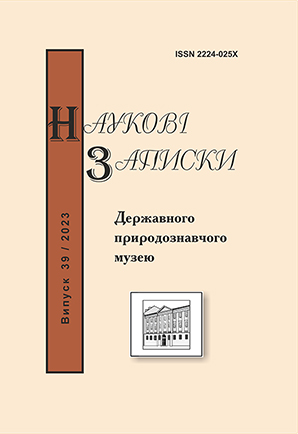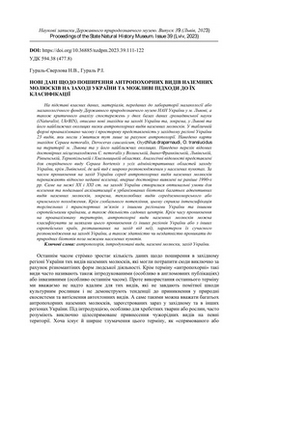Gural-Sverlova N.V., Gural R.I.
New data on the distribution of anthropochorous species of land molluscs in western regions of Ukraine and possible approaches to their classification // Proc. of the State Nat. Hist. Mus. - Lviv, 2023. - 39. - P. 111-122 DOI: https://doi.org/10.36885/nzdpm.2023.39.111-122 Key words: anthropochory, introduced species, land molluscs, western regions of Ukraine On the basis of own data, materials transferred to the laboratory of malacology or the malacological collection of the State Museum of Natural History of the National Academy of Sciences of Ukraine in Lviv, as well as a critical analysis of observations in two citizen science databases (iNaturalist, UkrBIN), new records of some anthropochorous land mollusc species in Western Ukraine, and in particular, in Lviv and its immediate surroundings, are described. In tabular form, the temporal and spatial presence in the western part of Ukraine of 23 species that could appear here only due to anthropochory is analyzed. Maps of the findings of Cepaea nemoralis, Deroceras caucasicum, Oxychilus draparnaudi, and O. translucidus in and near Lviv are given. Known reliable localities of C. nemoralis in Volyn, Ivano-Frankivsk, Lviv, Rivne, Ternopil, and Khmelnytskyi regions are listed. Similar information is presented for the related species Cepaea hortensis from all administrative regions of Western Ukraine, except for Lviv region, where this species is widespread in settlements. According to the time of penetration into Western Ukraine, among the anthropochorous species of land molluscs, relatively recent invaders prevail, which were first reliably discovered not earlier than in the 1990s. At the turn of the 20th and 21st centuries, optimal conditions for the introduction and subsequent acclimatization in urbanized biotopes of many adventitious species of land molluscs, in particular thermophilic species of Mediterranean or Crimean origin, emerged in Western Ukraine. In addition to global warming, this was facilitated by the intensification of trade and transport links with other regions of Ukraine and other European countries, as well as the activities of garden centres. Besides the time of entry into the analyzed area, anthropochorous species of land molluscs can be classified according to the ways of this penetration (from other regions of Ukraine or from other European countries located to the west of it), the nature of their present distribution in Western Ukraine, as well as the ability or inability to enter natural biotopes outside settlements.
New data on the distribution of anthropochorous species of land molluscs in western regions of Ukraine and possible approaches to their classification // Proc. of the State Nat. Hist. Mus. - Lviv, 2023. - 39. - P. 111-122 DOI: https://doi.org/10.36885/nzdpm.2023.39.111-122 Key words: anthropochory, introduced species, land molluscs, western regions of Ukraine On the basis of own data, materials transferred to the laboratory of malacology or the malacological collection of the State Museum of Natural History of the National Academy of Sciences of Ukraine in Lviv, as well as a critical analysis of observations in two citizen science databases (iNaturalist, UkrBIN), new records of some anthropochorous land mollusc species in Western Ukraine, and in particular, in Lviv and its immediate surroundings, are described. In tabular form, the temporal and spatial presence in the western part of Ukraine of 23 species that could appear here only due to anthropochory is analyzed. Maps of the findings of Cepaea nemoralis, Deroceras caucasicum, Oxychilus draparnaudi, and O. translucidus in and near Lviv are given. Known reliable localities of C. nemoralis in Volyn, Ivano-Frankivsk, Lviv, Rivne, Ternopil, and Khmelnytskyi regions are listed. Similar information is presented for the related species Cepaea hortensis from all administrative regions of Western Ukraine, except for Lviv region, where this species is widespread in settlements. According to the time of penetration into Western Ukraine, among the anthropochorous species of land molluscs, relatively recent invaders prevail, which were first reliably discovered not earlier than in the 1990s. At the turn of the 20th and 21st centuries, optimal conditions for the introduction and subsequent acclimatization in urbanized biotopes of many adventitious species of land molluscs, in particular thermophilic species of Mediterranean or Crimean origin, emerged in Western Ukraine. In addition to global warming, this was facilitated by the intensification of trade and transport links with other regions of Ukraine and other European countries, as well as the activities of garden centres. Besides the time of entry into the analyzed area, anthropochorous species of land molluscs can be classified according to the ways of this penetration (from other regions of Ukraine or from other European countries located to the west of it), the nature of their present distribution in Western Ukraine, as well as the ability or inability to enter natural biotopes outside settlements.
References
- Гураль-Сверлова Н.В., Гураль Р.І. 2021. Історія проникнення антропохорних видів молюсків на захід України. Наукові записки Державного природознавчого музею. Вип. 37. С. 173–180. DOI: https://doi.org/10.36885/nzdpm.2021.37.161-172
- Гураль-Сверлова Н.В., Гураль Р.І. 2022. Фенотипічні маркери та історія інтродукції садової цепеї Cepaea hortensis (Gastropoda, Helicidae) до заходу України. Наукові записки Державного природознавчого музею. Вип. 38. С. 83–94. DOI: https://doi.org/10.36885/nzdpm.2022.38.83-94
- Гураль-Сверлова Н.В., Савчук С.П. 2019. Антропохорні види наземних молюсків на заході України. Наукові записки Державного природознавчого музею. Вип. 35. С. 49–58. DOI: https://doi.org/10.36885/nzdpm.2019.35.49-58
- Гураль-Сверлова Н.В., Савчук С.П. 2020. Нові знахідки антропохорних видів наземних молюсків на заході України. Наукові записки Державного природознавчого музею. Вип. 36. С. 213–214. DOI: https://doi.org/10.36885/nzdpm.2020.36.213-214
- Климишин О.С. 2003. Природнича музейна термінологія: Словник-довідник. Львів. 244 с.
- Aubry S., Labaune C., Magnin F., Roche P., Kiss L. 2006. Active and passive dispersal of an invading land snail in Mediterranean France. Journal of Animal Ecology. Vol. 75. P. 802–813. DOI: https://doi.org/10.1111/j.1365-2656.2006.01100.x
- Balashov I., Kramarenko S., Shyriaieva D., Vasyliuk O. 2018. Invasion of a Crimean land snail Brephulopsis cylindrica into protect relict steppic hilltops (tovtrs) in Western Ukraine: a threat to native biodiversity? Journal of Conchology. Vol. 43. P. 59–69.
- Balashov I., Markova A. 2023а. Expansion of the invasive Balkan slug Tandonia kusceri (Stylommatophora: Milacidae): A new frontier in northern Ukraine and other new records. Folia Malacologica. Vol. 31. No. 1. P. 24-31. DOI: https://doi.org/10.12657/folmal.031.004
- Balashov I., Markova A. 2023b. A further northward expansion of the invasive land snails Monacha cartusiana and M. fruticola (Stylommatophora: Hygromiidae) in Eastern Europe. Folia Malacologica. Vol. 31 No. 1. P. 32–42. DOI: https://doi.org/10.12657/folmal.031.005
- Gural-Sverlova N., Gleba V.. Gural R. 2019. Einschleppung von Tandonia kusceri (Pulmonata: Milacidae) nach Transkarpatien und Verbreitung von Tandonia-Arten in der Ukraine. Malacologica Bohemoslovaca. Vol. 18. P. 19–26.
- Gural-Sverlova N.V., Gural R.I. 2020. First records of the land snail Monacha fruticola (Gastropoda, Stylommatophora, Hygromiidae) in Western Ukraine. Zoodiversity. Vol. 54 No. 2. P. 95–98. DOI: https://doi.org/10.15407/zoo2020.02.095
- Gural-Sverlova N., Gural R. 2021. Cornu aspersum (Gastropoda: Helicidae) in Western Ukraine with an overview of introduced species of land molluscs from this area. Malacologica Bohemoslovaca. Vol. 20. P. 123–135. DOI: https://doi.org/10.5817/MaB2021-20-123
- Gural-Sverlova N., Gural R. 2022. Shell colouration and different introductions of the land snail Cepaea hortensis (Gastropoda: Helicidae) into Western Ukraine. Folia Malacologica. Vol. 30 No. 4. P. 221–233. DOI: https://doi.org/10.12657/folmal.030.025
- Gural-Sverlova N., Gural R. 2023. Three introduced Monacha (Gastropoda: Hygromiidae) species in and near Lviv with remarks on M. cartusiana spreading in Ukraine and its western part. Folia Malacologica. Vol. 31 No. 2. DOI: https://doi.org/10.12657/folmal.031.
- Gural-Sverlova N. V., Pisaryev S. M., Gural R. I. 2022. Further and further east: Steppe land snail Xerolenta obvia (Gastropoda, Geomitridae) expands its range in Ukraine. Zoodiversity. Vol. 56. P. 403–412. DOI: https://doi.org/10.15407/zoo2022.05.403
- Gural-Sverlova N., Rodych T. 2023. First records of introduced slugs of the genus Limacus (Gastropoda: Limacidae) in the Lviv region and their present distribution in Ukraine Malacologica Bohemoslovaca. Vol. 22. P. 4–12. DOI: https://doi.org/10.5817/MaB2023-22-4
- Hausdorf B. 2000a. The genus Monacha in Turkey (Gastropoda: Pulmonata: Hygromiidae). Archiv für Molluskenkunde. Vol. 128. P. 61–151.
- iNaturalist. 2023. iNaturalist: A Community for Naturalist [online]. Available at: http://www.inaturalist.org [Accessed 28 March 2023].
- Kerney M.P., Cameron R.A.D., Jungbluth J.H., 1983. Die Landschnecken Nord- und Mitteleuropas. Hamburg-Berlin: Parey. 384 pp.
- Kurek K., Najberek K. 2009. From the Black Sea coast to Poland – an incredible journey of Monacha cartusiana (O. F. Müller, 1774). Folia Malacologica. Vol. 17 No. 1. P. 41–42. DOI: https://doi.org/10.2478/v10125-009-0005-0
- Pieńkowska J.R., Manganelli G., Giusti F., Lesicki A. 2015. Monacha claustralis (Rossmässler 1834) new to Polish and Czech malacofauna (Gastropoda: Pulmonata: Hygromiidae). Journal of Conchology.Vol. 42. P. 79–93.
- Trautner J., 2000. Ein Ferntransport der Kartäuserschnecke, Monacha cartusiana (O.F.Müller, 1774) (Gastropoda: Stylommatophora: Helicidae), mit Anmerkungen zur passiven Ausbreitung bei Schnecken. Malakologische Abhandlungen des Staatlichen Museums für Tierkunde Dresden. B. 20. S. 161–163.
- UkrBIN. 2023. UkrBIN: Ukrainian Biodiversity Information Network [online]. Available at: http://www.ukrbin.com [Accessed 28 March 2023].


